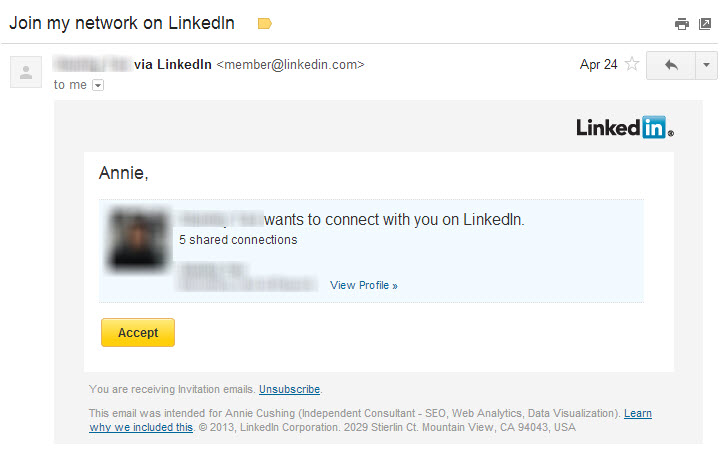LinkedIn Spam Invitation to Connect

As you may have experienced or heard of, LinkedIn spam invitation to connect is affecting many LinkedIn members and often these spam invitations lure vicatmabes into a fraud trap. Some cases may involve just receiving connection invitation emails which appear to be coming from LinkedIn, however, they do not impact the LinkedIn accounts. In these type of criminal cases, the recipient is asked to click a link within the email to accept the invitation or to view the person’s LinkedIn profile who is requesting the connection invitation. The links within these emails often route to another website potentially residing outside of the country which may even harm the computer with embedded malicious software programs. When you receive such emails, the best thing to do is DELETE the email REGARDLESS of whether the email is legitimately coming from LinkedIn and one of its legitimate members which I will explain shortly. The reason for my suggestion to delete the LinkedIn connection invitation email is because you can login to your LinkedIn account and see the invitation in your inbox and review the sender’s profile and decide to accept the invitation or not. If you don’t see the invitation in your LinkedIn inbox, then you should be glad that you deleted the email without clicking the link. And, if you see the invite in your LinkedIn account, read on.
We have another type of LinkedIn spam invitation to connect which is a little worse. In this case, the criminal actually creates a LinkedIn account with profile details including a nice picture and professional title like bank manager. If you ask yourself whether the picture is the actual person, that's a great start when assessing to accept a LinkedIn invitation or not. That being said, if the profile is a fake LinkedIn profile, then the picture is not the person. After the fake profile is created, the fraudster then starts to send a LinkedIn spam invitation to connect with other members which will now appear in the LinkedIn inbox which makes the request less suspicious specially if the criminal has been successful in connecting with a few other people whom you may know or may be part of your contact list as well. This is where critical thinking is required to decide whether to accept or reject the invitation. For one thing, don’t assume the nice picture is the person if you don’t know the person. If the LinkedIn spam invitation message is generic and references no one that you can contact and confirm, you should click the ignore button. This way, you avoid receiving LinkedIn reminders about the invitation and the person will be placed in a trouble bucket and prevented from sending future invitations to others. Otherwise, make sure the profile is fake and that you do not want the connection before you press ignore because you may place a legitimate account holder at risk if the person is labeled as a Linkedin spammer.
Interestingly, the scams are moving to social media where there are plenty of fish and although it’s hard to imagine these scams can fool the LinkedIn professionals, there are certainly some success stories. For example, in one case, after the LinkedIn member accepted the LinkedIn spam invitation to connect because she saw a shared contact, she soon received an email from the person who had indicated to be a bank professional in his LinkedIn title. The email was explaining the typical crap about the existence of a bank account with the victimabe’s exact last name and that they need a shipping address and money to send the check.
Now, if you've already accepted a criminal’s invitation, don’t worry and just remove him from your contact list. And although he or she may still have your email address, there is no chance of the criminal using your connection as a phishing bait to send a LinkedIn spam invitation and connect with your contacts.
Read another article about LinkedIn spam invitation.








